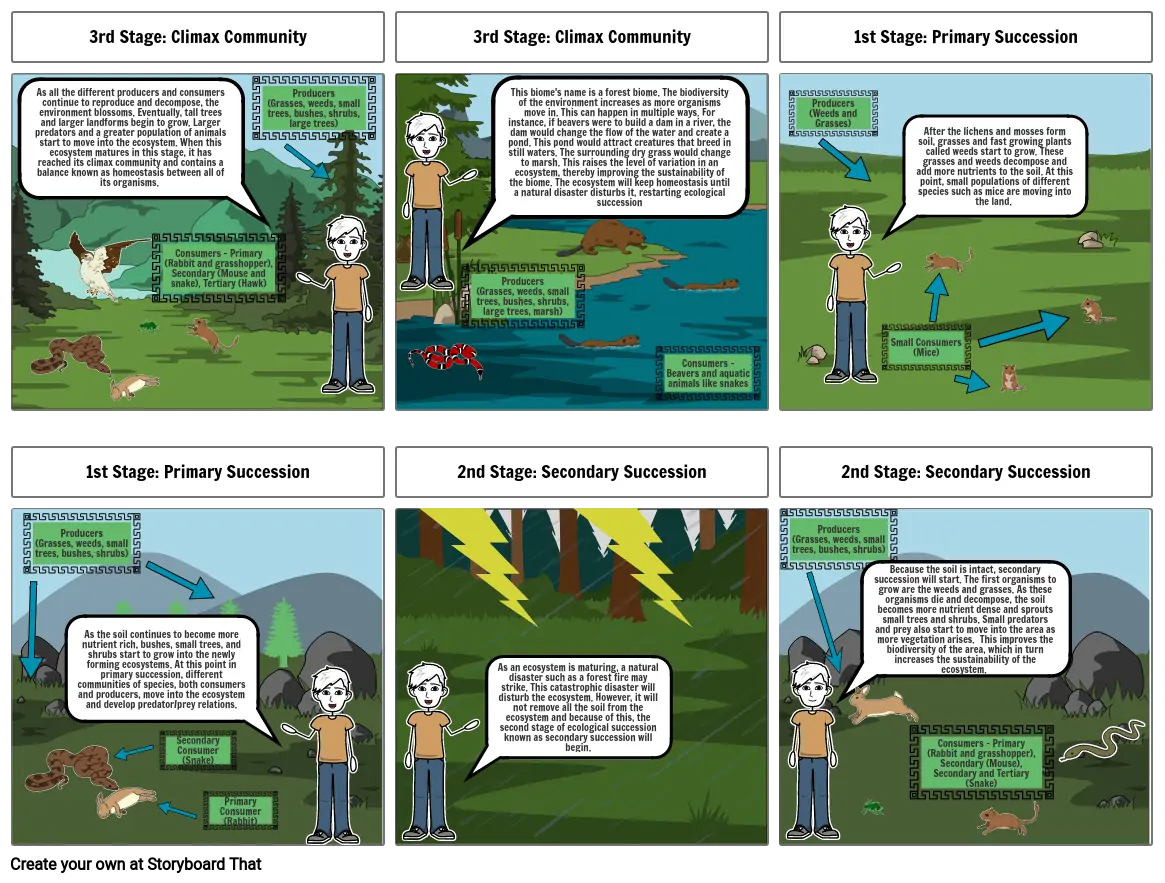Ecological Succession Illustration

Storyboard Text
- 3rd Stage: Climax Community
- As all the different producers and consumers continue to reproduce and decompose, the environment blossoms. Eventually, tall trees and larger landforms begin to grow. Larger predators and a greater population of animals start to move into the ecosystem. When this ecosystem matures in this stage, it has reached its climax community and contains a balance known as homeostasis between all of its organisms.
- Consumers - Primary (Rabbit and grasshopper), Secondary (Mouse and snake), Tertiary (Hawk)
- Producers(Grasses, weeds, small trees, bushes, shrubs, large trees)
- 3rd Stage: Climax Community
- This biome's name is a forest biome. The biodiversity of the environment increases as more organisms move in. This can happen in multiple ways. For instance, if beavers were to build a dam in a river, the dam would change the flow of the water and create a pond. This pond would attract creatures that breed in still waters. The surrounding dry grass would change to marsh. This raises the level of variation in an ecosystem, thereby improving the sustainability of the biome. The ecosystem will keep homeostasis until a natural disaster disturbs it, restarting ecological succession
- Producers(Grasses, weeds, small trees, bushes, shrubs, large trees, marsh)
- Consumers - Beavers and aquatic animals like snakes
- 1st Stage: Primary Succession
- Producers (Weeds and Grasses)
- After the lichens and mosses form soil, grasses and fast growing plants called weeds start to grow. These grasses and weeds decompose and add more nutrients to the soil. At this point, small populations of different species such as mice are moving into the land.
- Small Consumers (Mice)
- 1st Stage: Primary Succession
- Producers(Grasses, weeds, small trees, bushes, shrubs)
- As the soil continues to become more nutrient rich, bushes, small trees, and shrubs start to grow into the newly forming ecosystems. At this point in primary succession, different communities of species, both consumers and producers, move into the ecosystem and develop predator/prey relations.
- 2nd Stage: Secondary Succession
- As an ecosystem is maturing, a natural disaster such as a forest fire may strike. This catastrophic disaster will disturb the ecosystem. However, it will not remove all the soil from the ecosystem and because of this, the second stage of ecological succession known as secondary succession will begin.
- 2nd Stage: Secondary Succession
- Producers(Grasses, weeds, small trees, bushes, shrubs)
- Because the soil is intact, secondary succession will start. The first organisms to grow are the weeds and grasses. As these organisms die and decompose, the soil becomes more nutrient dense and sprouts small trees and shrubs. Small predators and prey also start to move into the area as more vegetation arises. This improves the biodiversity of the area, which in turn increases the sustainability of the ecosystem.
- Secondary Consumer (Snake)
- Primary Consumer (Rabbit)
- Consumers - Primary (Rabbit and grasshopper), Secondary (Mouse), Secondary and Tertiary (Snake)
Over 30 Million Storyboards Created

